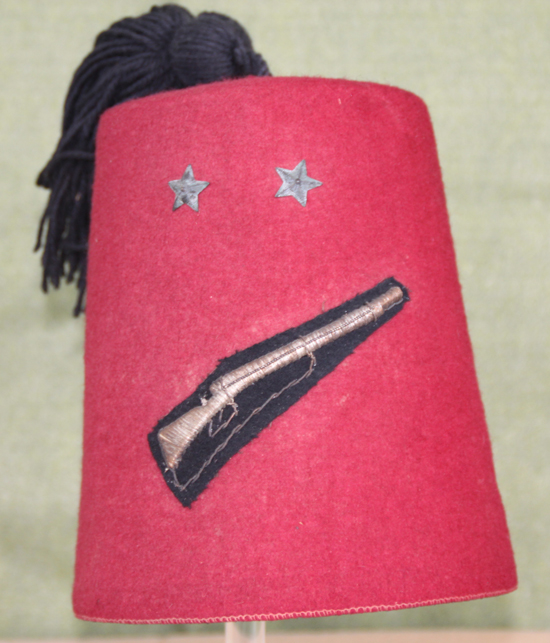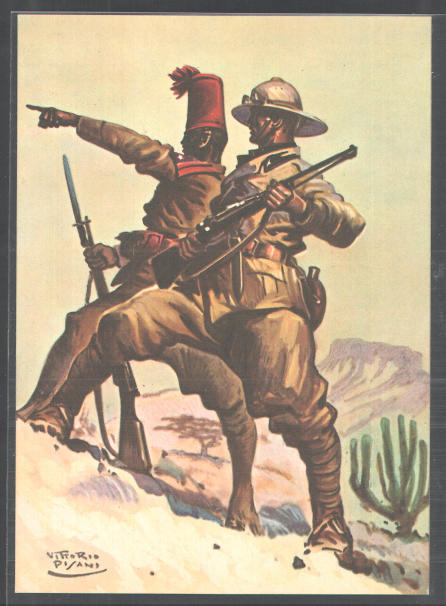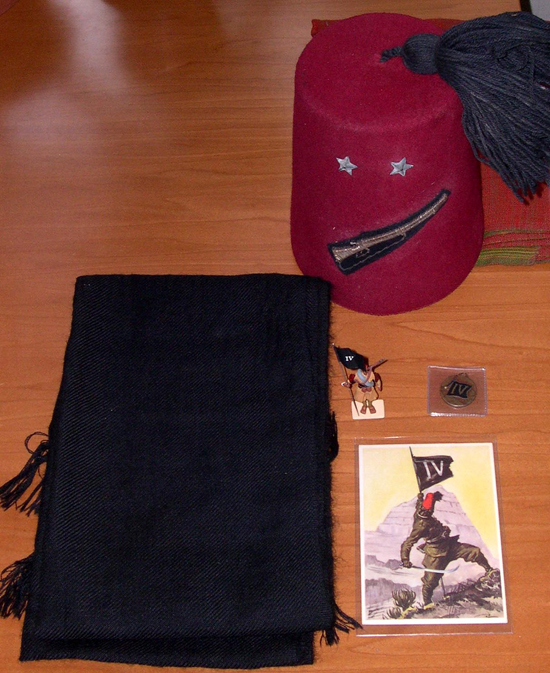The “tarbusc,” from the Persian Sarpush (headdress) is a hat similar to fez, a truncated cone shape, and was typical of the indigenous Italian troops in Eritrea and later AOI (Italian East Africa).
It was “inherited” by Egyptian troops stationed at Massawa, at the time of the first Italian occupation in 1885. The original version of the headdress was used by the irregular soldier of the Ottoman army, the Bashi Bazuk (“Mad Heads”) and was red with a black bow.
In 1888 with the arrival in the colony of Gen. Baldissera there was the reorganization of the departments of natives, and here appeared for the first time the term Ascaro – Askari soldiers. At this time Baldissera decided to organize regular troops departments of indigenous standardized also the uniform.
Four battalions were formed, the I, II, III and IV, which in 1895/96 were joined by another 4, V, VI, VII and VIII.
The battalions also wore as emblem a sash, called the Etaga – a strip of wool 2.30m long and 40cms high fixed to the waist of the same color for each Battalion.
I Battalion – Red
II Battalion – Blue
III Battalion – Crimson
IV Battalion – Black
V Battalion -Scottish color
VI Battalion – Green
VII Battalion -White
VIII Battalion – Fawn (dark yellow)
For indigenous artillery, the sash was black for mule batteries, and yellow for the fortress gunners. For mounted units Penne di Falco (hawk feather) tarbusc was wrapped in a sheet of Scottish color with a hawk feather stuck in.
From this reform the tarbusc became about 12cms tall, had red felt, and had at the center (top), where a hole was, a cord that was tied outside of the jib. Internally the Tarbush had no structure to stiffen it, but was coated in the lower part by a strip of Moroccan leather of 4.5 cms in height, to prevent contact with the head.
The infantry was equipped with tarbusc with chinstrap, and for the cavalry units with a chinchain.
The grades were applied on tarbush in the upper front.
The grades were as follows:
no stars soldier “Ascaro”
1 Star Corporal “Muntaz”
2 stars Sergeant “Buluk Bashi”
3 stars Marshall “Jusbasci,: (since 1908 replaced by Sciumbasci)
On the tarbusc under the stars was also applied to the patches of specialties, marksman for example. Towards the beginning of 1900 the tarbusc increased in height going to 20 cms and beyond.
The height of tarbusc seemed to increase the status of indigenous soldiers becoming a true symbol of strength and courage. The Eritrean Askari in fact were none too happy, when from 1913 a khaki cover was introduced for camouflage.
The Askari were even less enthusiastic towards the introduction of khaki cap in 1936, which was aimed at replacing the tarbusc.
The tarbusc was considered a hallmark of great value to the native troops, and
was also used in the free outputs and for “fantasies” festivals and religious ceremonies.
Piero Pompili
Bibliography:
“Uniforms and insignia of the Italian colonial troops” by Gabriel Zorzetto 1885-1943.
“Italian Colonial wars 1885-1900 “ by Raffaele Ruggeri;
The original Italian version of Piero’s article:
Il Tarbusc , dal persiano Sarpush (corpicapo ) e’ un copricapo simile al Fez, di forma tronco conica, ed era tipico delle truppe indigene Italiane in Eritrea ed in AOI (Africa Orientale Italiana).
Fu’ ereditato dalle truppe Egiziane di stanza a Massaua, all’epoca della prima occupazione Italiana nel 1885.
Nella versione iniziale , quando era in uso ai primi reparti indigeni , Baschi Buzuk ( teste matte) era di colore rosso , basso, floscio e provvisto di un fiocco nero.
Nel 1888 con l’arrivo in colonia del Gen. Baldissera ci fu’ la riorganizzazione dei reparti indigeni, e comparve per la prima volta il termine Ascaro (da Asker soldato ).
IL Baldissera decise di organizzare dei reparti di truppa regolari indigeni, regolamentandone anche l’uniforme.
Furono costituiti 4 battaglioni, il I, II, III e IV, a cui nel 1895/96 se ne aggiunsero altri 4, il V, VI, VII e VIII.
I battaglioni avevano come segno distintivo il fiocco del tarbusc e la fascia Etaga’ ( fascia di lana lunga 2.30 mt ed alta 40 cms fissata alla vita) dello stesso colore per ogni Battaglione.
I rosso
II azzurro
III cremisi
IV nero
V scozzese
VI verde
VII bianco
VIII fulvo (giallo scuro)
Per i reparti di artiglieria indigena, il fiocco era nero per le batterie someggiate, e giallo per i cannonieri da posizione,. Per i reparti montati Penne di Falco il tarbusc era avvolto da un telo di colore scozzese con una penna di falco infilata.
Da questa riforma il Tarbusc divenne alto circa 12 cms, era in feltro rosso, aveva al centro ( nella parte superiore ) un foro dove era fissato un cordoncino a cui andava legato esternamente il fiocco.
Internamente il Tarbusc non aveva nessuna struttura interna per irrigidirlo, era rivestito internamente nella parte bassa da una striscia di marocchino di 4,5 cms di altezza, per evitare il contatto con la testa.
Il Tarbusc di fanteria era dotato di sottonuca, quello per i reparti montati di sottogola.
I gradi venivano applicati sul Tarbusc nella parte frontale superiore.
I gradi erano i seguenti:
nessuna stella Ascaro soldato semplice
1 stella Muntaz caporale
2 stelle Buluk Bashi sergente
3 stelle Jusbasci, (dal 1908 sostituito da Sciumbasci Maresciallo)
Piu’ in basso sul Tarbusc sotto le stellette veniva applicato anche il fregio di specialita’, tiratore scelto per esempio.
Verso gli inizi del 1900 l’altezza del Tarbusc aumento’ andando a raggiungere i 20 cms ed anche oltre.
L’altezza del Tarbusc sembrava aumentare lo status del soldato indigeno che lo portava; diventando un vero e proprio simbolo di forza e coraggio.
Gli Ascari Eritrei , infatti, non furono affatto contenti di doverlo rivestire( dal l 1913) con un telino cachi per mimetizzarlo. Ne’ tanto meno apprezzarono l’introduzione della bustina cachi nel 1936, che era tesa alla sostituzione del Tarbusc.
IL tarbusc e’ sempre stato un elemento distintivo e di grande pregio per le truppe indigene, e veniva usato anche nelle libere uscite e nelle “ fantasie “ feste e cerimonie religiose.
Piero Pompili
Bibliografia:
Uniformi e insegne delle truppe coloniali Italiane 1885-1943 Gabriele Zorzetto.
Le guerre coloniali Italiane 1885-1900 Raffaele Ruggeri;




Stupenda spiegazione ho un fez dello stesso tipo dove riporta la dicono deposito ascari r.e. massaua 1889.
Magnifico.Si può avere immagine? Grazie Andrea.franco@magnetimarelli.com